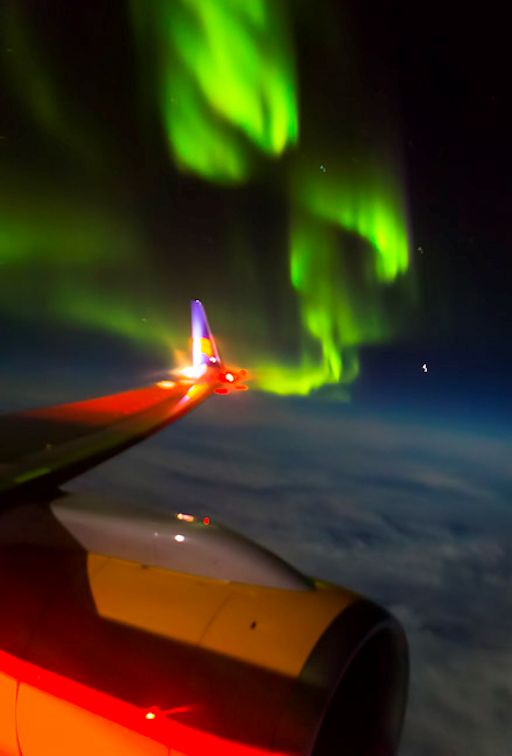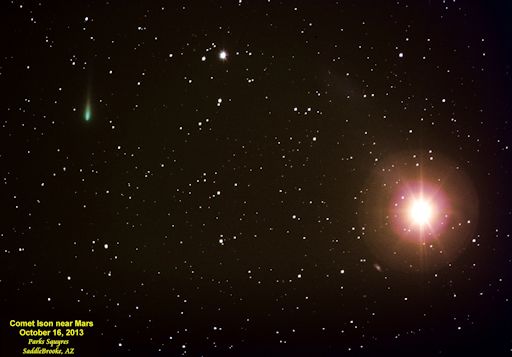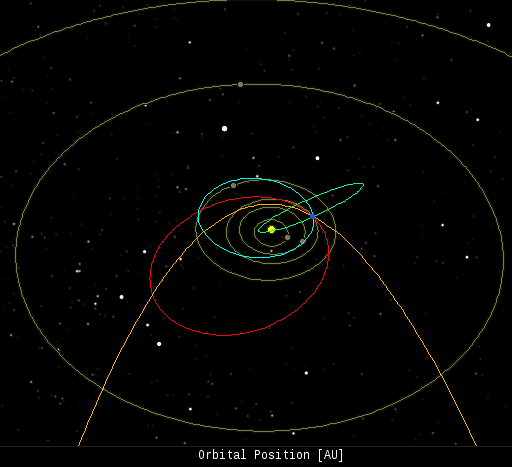FAINT ECLIPSE OF THE HUNTER'S MOON: According to folklore tonight's full Moon is the Hunter's Moon. It gets its name from Native American hunters who once tracked their prey by autumn moonlight, stockpiling food for the winter ahead. This year's Hunter's Moon is special because it will pass through the outskirts of Earth's shadow, producing a dusky shading in the southern half of the Moon. The faint lunar eclipse will be visible to the naked eye during a 40 minute period beginning at 23:30 UT (7:30 EDT) on Oct. 18th. Sky watchers in Africa and Europe are favored with the best views. [details] [map]
CHOOSE THE WINDOW SEAT: The next time you board an airplane with a northern flight path, choose the window seat. Photographer David Mayhew settled in next to the port wing of a flight from Denver to Iceland on October 14th, and this is what he saw through the glass:
"We were somewhere over the Hudson Bay," says Mayhew. "I rested the lens against the window and held a blanket over my head to reduce reflections - got plenty of odd looks from the other passengers!!"
NOAA forecasters estimate a 20% chance of polar geomagnetic storms on Oct. 17th. This means there is at least a 1-in-5 chance of a good view for Arctic fliers. Choose the window seat, indeed. Aurora alerts: text, voice.
GREEN COMET, RED PLANET: Comet ISON, which will fly through the atmosphere of the sun on Nov. 28th, is now flying past the planet Mars. The green comet and the Red Planet are just 1o apart in the eastern sky before dawn. Parks Squyres photographed the odd couple from his private observatory in SaddleBrooke, Arizona, on Oct. 16th:
Mars is almost as bright as a 1st-magnitude star, easy to find in the constellation Leo near the blue star Regulus. The comet, on the other hand, is invisible to the unaided eye. Mid-sized backyard telescopes are required to see it.
"I used a Celestron 11-inch telescope," says Squyres. "The image is a stack of 80 15-second exposures."
The comet is green because its vaporizing nucleus emits diatomic carbon, C2, a gas which glows green in the near-vacuum of space. Mars is red because its rocky surface is widely rusted. The two colors make a heavenly ensemble. Amateur astronomers, if you have a GOTO telescope, enter these coordinates, and let the exposures begin.
Realtime Comet ISON Photo Gallery
Realtime Space Weather Photo Gallery
| All Sky Fireball Network |
NEW: Every night, a network of NASA all-sky cameras scans the skies above the United States for meteoritic fireballs. Automated software maintained by NASA's Meteoroid Environment Office calculates their orbits, velocity, penetration depth in Earth's atmosphere and many other characteristics. Daily results are presented here on Spaceweather.com.
On Oct. 18, 2013, the network reported 4 fireballs.
(3 sporadics, 1 epsilon Geminid)
In this diagram of the inner solar system, all of the fireball orbits intersect at a single point--Earth. The orbits are color-coded by velocity, from slow (red) to fast (blue). [Larger image] [movies]

Solar wind
speed: 367.6 km/sec
density: 1.0 protons/cm3
explanation | more data
Updated: Today at 2246 UT
X-ray Solar Flares
6-hr max: C2 1601 UT Oct18
24-hr: C8 1526 UT Oct18
explanation | more data
Updated: Today at: 2200 UT
![]()
Daily Sun: 18 Oct 13
Departing sunspot AR1861 poses a threat for M-class solar flares. Amateur astronomers should train their solar telescopes on the sun's western limb. Credit: SDO/HMI
![]()
Sunspot number: 166
What is the sunspot number?
Updated 18 Oct 2013
Spotless Days
Current Stretch: 0 days
2013 total: 0 days (0%)
2012 total: 0 days (0%)
2011 total: 2 days (<1%)
2010 total: 51 days (14%)
2009 total: 260 days (71%)
Since 2004: 821 days
Typical Solar Min: 486 days
Update 18 Oct 2013
The Radio Sun
10.7 cm flux: 136 sfu
explanation | more data
Updated 18 Oct 2013
![]()
Current Auroral Oval:
Switch to: Europe, USA, New Zealand, Antarctica
Credit: NOAA/POES
![]()
Planetary K-index
Now: Kp= 2 quiet
24-hr max: Kp= 2 quiet
explanation | more data
Interplanetary Mag. Field
Btotal: 3.3 nT
Bz: 1.4 nT north
explanation | more data
Updated: Today at 2246 UT
![]()
Coronal Holes: 18 Oct 13
Solar wind flowing from this coronal hole should reach Earth on Oct. 21-22. Credit: SDO/AIA.







